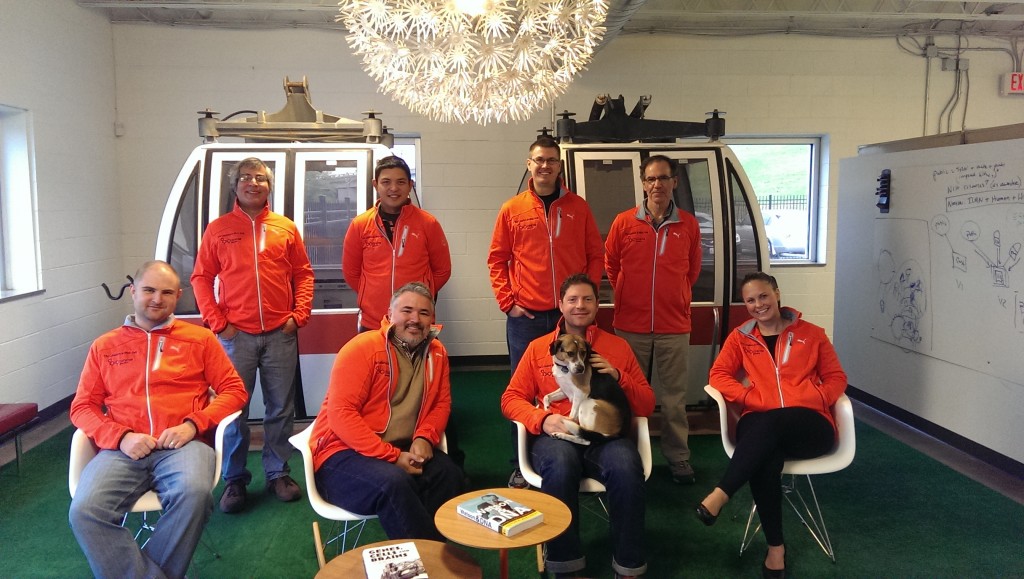Don’t Miss our Exciting Work in RNA Discovery with our Collaborators from Pacific Biosciences and Nugen
(Hint, we will be the ones wearing orange jackets)
Representatives from Cofactor will be at the AGBT meeting in Orlando February 10-13. On the Pacific Biosciences front we will be presenting our results on a transcriptome normalization method that allows researchers to characterize deeper into the transcriptome pool to pick up additional isoforms and fusions (full abstract below).
Second, we will be presenting our results from our collaboration with NuGEN. Work that is targeted at understanding the RNA cargo (ie mRNA, long non-coding RNA, and circular RNA) that is present in exosomes and methods to characterize this component of exosomes (full abstract below).
Want to learn more or meet at AGBT? Get in touch.
About Cofactor Genomics
Cofactor Genomics develops products and protocols to standardize RNA-seq. Founded by three former Human Genome Project molecular and data scientists, Cofactor is a research partner for 9 of the world’s largest Pharma Companies. Together they are enabling the world’s top scientists to confidently use RNA-seq in their research. Cofactor’s offerings include their standardized RNA-seq offerings as well as FFPE and low-input products.
Find out more about Cofactor at: https://www.cofactor.wpengine.com.
RNA Isoform and Fusion Discovery on the Pacific Biosciences Platform using an Efficient and Robust Method for Normalizing Transcriptome Samples
Casey Jowdy1*, Matthew Botiano2*, Jon R. Armstrong1, Ajay Khanna1, Steve Kujawa2 and Tyson Clark2
- Cofactor Genomics, St. Louis, MO 2. Pacific Biosciences, Menlo Park, CA
*These authors contributed equally to this work
RNA sequencing (RNA-Seq) using short-read next-generation sequencers (e.g. Illumina) is a powerful method for identifying differentially expressed transcripts. However, given the read lengths of short-read sequencing technologies (~100 bp), it remains challenging to characterize full-length transcripts for accurate identification of alternatively spliced isoforms and transcript fusion events. Previous hybrid approaches, combining accurate short-read and now obsolete long-read technologies (454 FLX+ ~800 bp), were an improvement over short reads alone but were expensive and computationally challenging to analyze [1]. Long-read sequencing platforms such as Pacific Biosciences RS II have the potential to overcome the limitations of short read platforms by producing sequence reads that span the entire length of an RNA molecule. The Iso-Seq protocol from Pacific Biosciences currently produces reads that extend from the 5’ end to the poly(A)-tail of the transcript [2]. However, there are several factors that limit this approach for comprehensive isoform and fusion detection, including amount of RNA material required, complexity of the library protocol and relatively high cost to generate large amounts of sequence data to characterize low abundance molecules. If a method were available to mitigate these factors, the research community would be able to apply these tools to more sample types and/or replicates for the discovery of novel transcript isoforms and fusions to gain insight into the mechanisms, physiology, and pathogenesis of disease. We have developed a transcriptome normalization method, using double-stranded nuclease (DSN) which requires only a microgram of RNA, mitigates the need for size selection during the library protocol, and reduces the sequencing depth required for isoform and fusion detection. We have applied this method to multiple samples of Universal Human Brain RNA and will report the relative proportion of transcripts before and after normalization, the fold-increase in sensitivity of isoform and fusion detection and the cost-savings provided by our method.
References
- Finseth FR, Harrison RG. A Comparison of Next Generation Sequencing Technologies for Transcriptome Assembly and Utility for RNA-Seq in a Non-Model Bird. Gibas C, ed. PLoS ONE. 2014;9(10):e108550. doi:10.1371/journal.pone.0108550.
- Chin J, Peluso P, Rank D, et al. SMRT® Sequencing Solutions for Large Genomes and Transcriptomes. Journal of Biomolecular Techniques : JBT. 2014;25(Suppl):S15.
A Method for Surveying the Long-RNA Landscape of Exosomes
Jon R. Armstrong1, Jeff Hiken1, Ajay Khanna1, Stephanie Huelga2, Luke Sherlin2 and Doug Amorese2
- Cofactor Genomics, St. Louis, MO 2. NuGEN, San Carlos, CA
The emergence of next-generation sequencing platforms has enabled the discovery and interrogation of RNA from tissues, biofluids, and extracellular vesicles at remarkable levels. Recently, interest has grown in sequencing RNA found in extracellular vesicles called exosomes, because of their role in cell-cell communication and immunoregulatory processes [1]. The contents of exosomes have been shown to consist of multiple RNA types including, micro RNA (miRNA) and messenger RNA (mRNA), as well as other biologically active molecules [2, 3]. Extensive work has focused on assessing the miRNA content of exosomes and it’s role as a putative disease biomarker. However, other types of RNA, such as long-RNA (> 200 bp; lncRNA, mRNA, and circular RNA), may play an equal or more important role in cellular communication and cause alterations to biological pathways that affect disease development. Long-RNA is a minor proportion of the RNA material in exosomes and until recently, it was extremely challenging to generate sequencing libraries from the very small amounts of long-RNA extracted from exosomes. However, new methods have emerged, such as NuGEN’s Ovation® Single Cell RNA-Seq System, which enable a single library to be generated from extremely small amounts of long-RNA, and unlike poly(A) library methods, retain the full complement of long-RNA species (e.g. lncRNA, mRNA, and circular RNA). In order to investigate the population of long-RNA molecules in exosome samples we applied the Ovation® Single Cell RNA-Seq System to total RNA extracted from exosomes. The libraries were sequenced and the resulting data was analyzed to identify the landscape of long-RNA species. We will present the method workflow, number and types of observed long-RNA’s and relative proportions of long-RNA’s across multiple control and renal cancer exosome samples.
- Théry C., Ostrowski M., Segura E. Membrane vesicles as conveyors of immune responses. Nature Reviews Immunology. 2009;9(8):581–593.
- Valadi H, Ekstrom K, Bossios A, Sjostrand M, Lee JJ, Lotvall JO.. Exosome-mediated transfer of mRNAs and microRNAs is a novel mechanism of genetic exchange between cells. Nat Cell Biol. 2007:9(6):654–9.
- Schorey JS, Bhatnagar S. Exosome Function: From Tumor Immunology to Pathogen Biology. Traffic (Copenhagen, Denmark). 2008;9(6):871-881.





